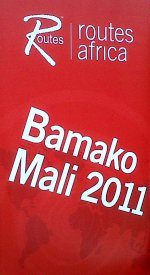ROUTES AFRICA: ASM Workshops Highlight Route Opportunities
Executives from respected consultancy Airport Strategy and Marketing (ASM) delivered the opening addresses to delegates at the Routes Africa yesterday. First up on the stage was Mark Clarkson, Vice President of Consultancy Services who highlighted the importance for airports to understand the dynamics of their market.
“The world of aviation is a competitive one and this is certainly the case in West Africa with many countries seeking to gain new air services both intra-regionally and further afield to Europe and Asia in particular. There is only so much airline metal to go around so it is vitally important to understand your market, the drivers for your target airlines and make you airports stand out from the crowd,” he said. According to official IATA data, Africa’s airports grew by around 1.1 per cent in May 2011, in comparison to the same month last year, with the market still depressed by the impact of political tensions in Egypt and Tunisia. There remains a great opportunity for development, according to Mark, as Trans National Corporations (TNCs) from developing economies make a rapid entry into the continent providing additional development opportunities and access to global markets. The World Bank’s new Africa Strategy even suggests that the continent could be on a brink an economic take-off much like India was around 20 years ago and China ten years earlier.
According to official IATA data, Africa’s airports grew by around 1.1 per cent in May 2011, in comparison to the same month last year, with the market still depressed by the impact of political tensions in Egypt and Tunisia. There remains a great opportunity for development, according to Mark, as Trans National Corporations (TNCs) from developing economies make a rapid entry into the continent providing additional development opportunities and access to global markets. The World Bank’s new Africa Strategy even suggests that the continent could be on a brink an economic take-off much like India was around 20 years ago and China ten years earlier.
International trade and commerce is of primary importance to airports throughout Africa and aviation plays a very natural and essential part in both maintaining connections and facilitating growth. Taking Mali as an example, according to World Trade Organisation data from 2009, South Africa is the main destination for exports from Mali, and Europe the main source for imports.
“Alongside this air travel between Africa and Europe has grown in the last 12 months by around five per cent and China, a burgeoning source of import trade for the continent, has grown 14 per cent,” Mark added. In a presentation titled The Growth of China in Africa – Route Development with Gulf and Chinese Carriers, he highlighted how combined the Chinese and Middle East markets could play an important role in air service development across the continent.
In a presentation titled The Growth of China in Africa – Route Development with Gulf and Chinese Carriers, he highlighted how combined the Chinese and Middle East markets could play an important role in air service development across the continent.
“China’s investment in Africa over recent years is clear,” explained Mark. “The average annual growth rate of China-Africa trade between 2000 and 2008 was 33.5 per cent and although volumes dropped to US$91 billion in 2009 as a result of the international financial crisis, China became Africa's largest trade partner that year for the first time. The following year witnessed strong growth and in the first eleven months of 2010 trade reached US$115 billion, a year-on-year growth of 43.5 per cent.”
China’s investment in Africa has largely targeted the oil, gas and mining industries but is expanding into manufacturing, real estate, infrastructure and other sectors such as finance and the country has established special economic zones across the continent to support its focus. Such investment naturally brings air service opportunities.
According to historic schedule data there were only two countries in Africa with non-stop or through services to China at the start of the last decade. Fast forward ten years to today and there are ten, with the amount of available seats trebling in the past five years. The market is dominated by Emirates Airline with a 27 per cent share, highlighting the important role that Middle East carriers could play in the development of air links between China and Africa.
“Of all the ‘to/from’ or ‘within’ regions, there are only two with growth over the decade in excess of 100 per cent. One is to/from the Middle East and the other…Africa-China,” he explained. “Currently airlines are looking at offering an en route stop between the two markets and airports in Africa need to ensure they are ready to take advantage of these growing markets. China and the Middle East are undeniably two very important regions for Africa in the medium- term and airports need to understand the markets and prove their business case to airlines.” Nick Oldrini, Research & Analysis Manager, ASM followed Mark Clarkson on to the stage and provided a brief introduction to the complexities of forecasting. As he highlighted in his introduction, such a topic could easily be the subject of a three day seminar rather than just a one hour workshop. The presentation echoed the view that it is essential that airports understand all the intricacies of the market and noted the obvious but often forgotten concept that airlines expect a return on any investment into an airport.
Nick Oldrini, Research & Analysis Manager, ASM followed Mark Clarkson on to the stage and provided a brief introduction to the complexities of forecasting. As he highlighted in his introduction, such a topic could easily be the subject of a three day seminar rather than just a one hour workshop. The presentation echoed the view that it is essential that airports understand all the intricacies of the market and noted the obvious but often forgotten concept that airlines expect a return on any investment into an airport.
You may question just how much money an airline will invest in a new route, well the answer is an awful lot of money, and much of that would be before the aircraft has even departed the runway due to fixed ownership costs and indirect costs such as crewing etc. Obviously operating costs vary by aircraft type and some will be preferred over others depending on the market segment but these investments could reach a figure of around US$44 million per annum for a daily Boeing 747-400 service, according to Nick Oldrini.
As he noted, the industry is changing: “Historically the simple belief was to have low costs and a high yield, a business model that has worked well for a long period of time. However, in today’s competitive environment the dynamic has changed and costs are rising and yields are falling.”
Using a hypothetical example he showed just what impact increasing variable costs could have on an airline’s service, highlighting that if the price of fuel doubled it could easily turn a profitable route making around €500,000 into a route losing around €1.5 million. A large number of variables can impact the success of any new route and Nick Oldrini detailed the various techniques that can be used to forecast demand, market share and the importance of tailoring the analysis to individual markets and operators. “A low-cost carrier would expect a very different break-even load factor to a full service carrier and likewise a charter operator,” he said. “You need to quantify the market to understand it and that can include a range of factors including economic indicators, tourism demand, industry links and diaspora. However, forecasting is not an exact science.”




